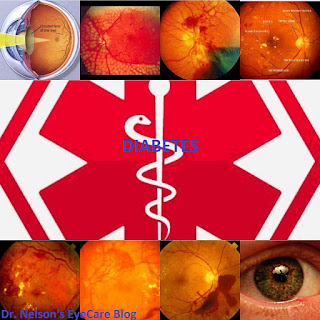Although diabetes affects the eyes in various ways, the main
vision problem is the one it does on the retina (diabetic retinopathy).
Diabetes affects the eye in the following ways.
Diabetic Retinopathy;
Retinopathy simply means damage to the retina and diabetic retinopathy
occurs when this retinal damage is caused by diabetes. Diabetic retinopathy is the leading new cases
of blindness in adults between 20-74 years of age. There are blood vessels in
the retinal area and in diabetic retinopathy, these blood vessels contains
small balloon-like swellings (that contains blood) on their surface
(microanurysm). These balloon-like swellings may burst and leak blood into the
retina.
In advanced stages of diabetic retinopathy, the retinal
blood vessels are blocked leading to obstruction of blood supply that nourishes
the retina. The retina sends signals to the body which triggers the production
of new blood vessels (neo-vascularization). These new blood vessels are weak
and usually rupture thereby causing hemorrhages which severely affects the patient’s
vision up to the extent of vision loss especially when blood reaches the
macular-the small sensitive area in the center of the retina that provides
detailed vision.
Untreated diabetic retinopathy causes irreversible damage to
the retina and eventually leads to blindness.
Change of Eye
Refractive Status; The refractive status of the eye simply means the state
of the eye as regards to whether it is long-sightedness (hyperopia) or short-sightedness
(myopia). Elevated blood sugar level as seen in diabetes causes the crystalline
lens (the transparent and biconvex structure in the eyes) to swell thereby
increasing its curvature and power. For normal vision, light that enters the
eyes from viewing objects are focused on the retina but when the lens curvature
increases (as in high blood sugar level), the power of the lens is increased
which now bends the light to focus before the retina and hence leads temporary
myopia (short-sightedness). This condition becomes resolves when the blood
sugar level is brought back to its normal level (usually after three months).
Any diabetic patient that has blurred vision should not go for glasses as their blurred vision
may be caused by the temporary increase in lens curvature and power due to
elevated blood sugar level. However glasses can only be prescribed for these
patients only if their blood sugar level is at its target range (90-130mm/dl
before meal and less than 180mm/dl one to two hours after meal).
The three major eye problems that diabetic patients are at
high risk of developing and of which they should be aware of are cataract,
glaucoma and retinopathy. Among them, diabetic retinopathy is the most
condition to occur and if not properly managed may lead to severe vision loss.
Diabetic patients should try as much as possible to control
their blood sugar level and should desist from starchy foods. In addition,
thorough eye examination by an eye doctor will help review the eye
manifestations of diabetes and early medical intervention will prevent further
damage.
Diabetic patients are advised to always maintain their blood
sugar level at the target range and should go for thorough eye examination by
an optometrist.


ليست هناك تعليقات:
إرسال تعليق
We love to hear from you!
Please share your thought here!